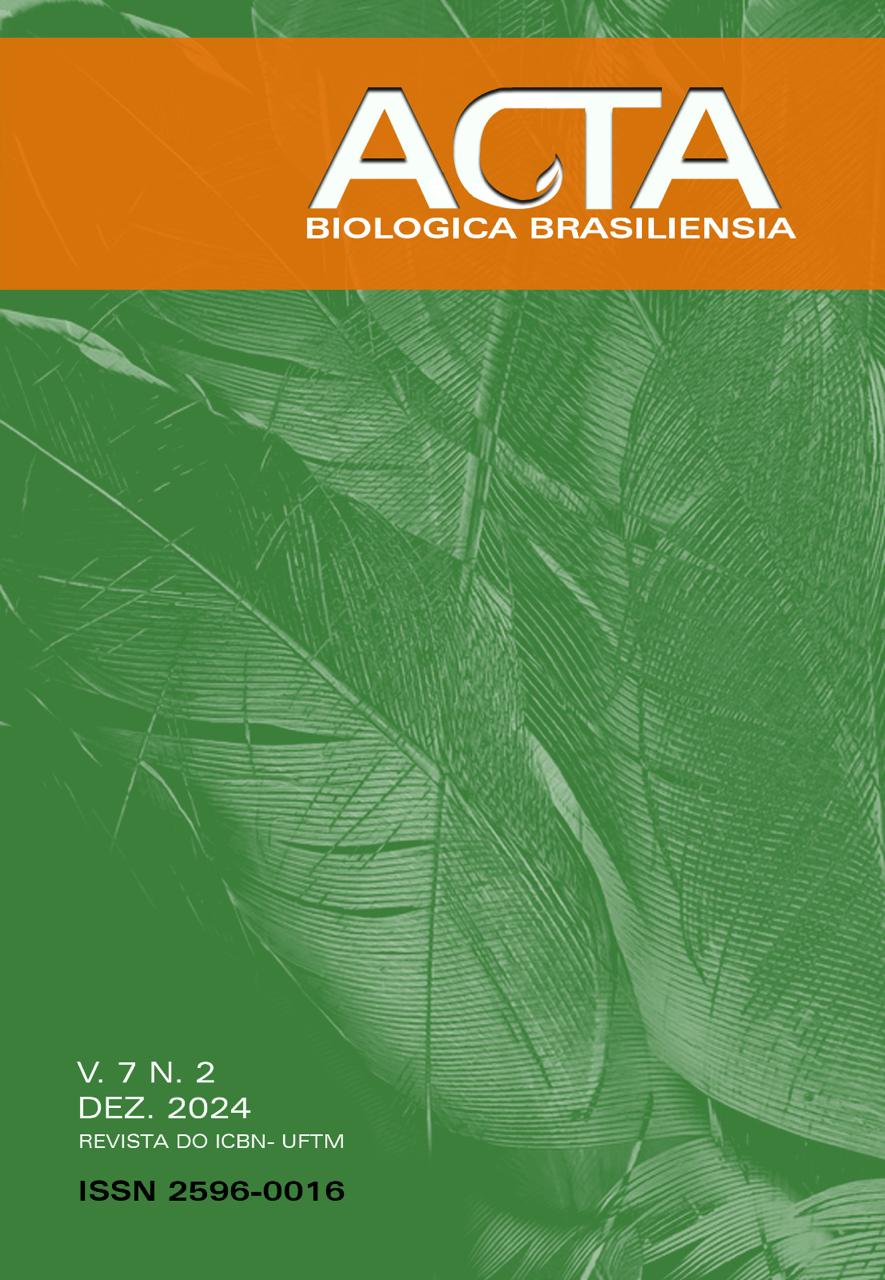PROPOSTA DE CULTIVO PARA A MOLINÉSIA NEGRA - Poecilia sphenops (Valenciennes, 1846)
DOI:
https://doi.org/10.18554/acbiobras.v7i2.8080Keywords:
parâmetros físico-químicos, aquicultura, qualidade da águaAbstract
Poecilia sphenops is one of the most popular and ornamental freshwater fish species worldwide. Environmental factors such as feeding frequency, light, photoperiod and salinity influence the growth and survival of the species. The performance of the species was studied under laboratory conditions, physical-chemical monitoring of the vivarium water was carried out between January 2019 and July 2020, with a total of 70 samples in four boxes used for maintenance and breeding of the herd. The physicochemical parameters (Temperature, pH, DO, Electrical Conductivity, Total Settleable Solids, Turbidity and Oxidation-Reduction Potential) were considered adequate for fish farming, however the Salinity parameter was outside of those recommended by other studies. Therefore, more studies with Poecilia sphenops in controlled environments will be necessary, as this species has potential for use in environmental quality research.
References
Santos ES, Silva TG, Freitas RM. Diferentes concentrações de Eugenol na anestesia de Molinésia Mollienesia sp. Revista Brasileira de Engenharia de Pesca. 2016; 9(2):10-18. https://doi.org/10.18817/repesca.v9i2.1007.
Mitjana O, Bonastre C, Insua D, Falceto MV, Esteban J, Josa A, Espinosa E. The efficacy and effect of repeated exposure to 2-phenoxyethanol, clove oil and tricaine methanesulphonate as anesthetic agents on juvenile Angelfish (Pterophyllum scalare). Aquaculture. 2014; 433: 491-495. https://doi.org/10.1016/j.aquaculture.2014.07.013.
Küçük S. The effects of water type on growth, survival and condition of Poecilia velifera. Afr. J. Biotechnol. 2010; 9:760-763. https://doi.org/10.5897/AJB09.1734.
Odountan OH, Bisthoven LJ, Abou, Y, Eggermont H. Biomonitoring of lakes using macroinvertebrates: recommended indices and metrics for use in West Africa and developing countries. Hydrobiologia. 2019; 826(1):1-23. https://doi.org/10.1007/s10750-018-3745-2.
Balamurugan J, Ajith KTT, Prakash S, Meenakumari B, Balasundaram C, Harikrishnan R. Clove extract: A potential source for stress free transport of fish, Aquaculture. 2016; 454(1):171-175. https://doi.org/10.1016/j.aquaculture.2015.12.020.
FAO (2015). IFAD, 2012: The State of Food Insecurity in the World: Economic growth is necessary but not sufficient to accelerate reduction of hunger and malnutrition. Food and Agriculture Organization of the United Nations, Rome, Italy.
Sirimanna SR, Dissanayake C. Effects of culture conditions on growth and survival of Poecilia sphenops and Poecilia reticulata. International Journal of Aquatic Biology. 2019; 7(4):202-210. https://doi.org/10.22034/ijab.v7i4.570.
Sudha, C. Study on induced breeding in ornamental fish, Poecilia sphenops. European Journal of Experimental Biology. 2012; 2(4):1250-1255.
Dzikowski R, Hulata G, Karplus I, Harpaz S. Effect of temperature and dietary l-carnitine supplementation on reproductive performance of female guppy (Poecilia reticulata). Aquaculture.2001; 199(3):323-332. https://doi.org/10.1016/S0044-8486(01)00561-0.
Parameshwaran K, Edirisinghe U, Dematawewa CMB, Nandasena KG. Effect of live and formulated feeds on larval growth and survival of guppy (Poecilia reticulata) reared in indoor tanks. Tropical Agricultural Research. 2011; 13:421-430.
Santos ES, Mota S, Santos AB, Aquino MD. Cultivo do peixe ornamental molinésia (Poecilia sp.) em esgotos domésticos tratados: desempenho zootécnico e avaliação do bem-estar animal. Arquivo Brasileiro de Medicina Veterinária e Zootecniav. 2015; 67(1): 255-264. https://doi.org/10.1590/1678-7501.
Moreira BT, Silveira CB, Oliveira AF, Coimbra JLM, Mello GL. Efeito da reticulação do alginato de sódio na produção de rações para pescado. Revista Brasileira de Higiene e Sanidade Animal. 2020; 14(3): 1-11. http://dx.doi.org/10.5935/1981-2965.20200029.
Barroncas MF, Pereira-filho M, Gomes LDC, Roubach R, Ono EA. Efeitos da troca de água sobre os índices zootécnicos e qualidade dos efluentes na criação intensiva do tambaqui (Colossoma macropomum) em viveiros escavados. Revista Brasileira Engenharia Pesca. 2015; 8(1): 49-71.
Cunha MCD, Costa ACV, Boor MAV, Costa FN. Microbiological and physical-chemical characteristics of the water used to Tambaqui Colossoma macropomum species, in Maranhão State. Revista Brasileira Saúde Produção Animal. 2017; 18(3): 430-438. https://doi.org/10.1590/S1519-99402017000300003.
Macedo CF, Sipauba-Tavares LH. Eutrofização e qualidade da água na piscicultura: consequências e recomendações. Boletim do Instituto de Pesca. 2010; 36(2):149-163.
Varghese, V, Nagarani, N, Balasubramani, A. 2021. Acute and Chronic Toxicity of Endocrine Disruptive Heavy Metals and Pesticides Exposed to Freshwater Fish P. reticulata and P. sphenops. Current World Environment. 2021; 16(2). https://doi.org/10.12944/cwe.16.2.09.
Azhagu RR, Hemalatha K, Sudhakani B, Ari KM, Jeya ME, Balachandar M. Impact of Household Chemicals on the Ornamental Fish Poecilia sphenops (Valenciennes). International Journal of Scientific Research in Science, Engineering and Technology. 2023; 10 (2): 35-40. https://doi.org/10.32628/ijsrset231021.
Lara-Flores M, Sharma, J. Expression of estrogenic response genes in black mollies (Poecilia sphenops) exposed to pyrogenic hydrocarbon and petroleum from campeche sound. Agricultural Science Digest - A Research Journal. 2020; 40 (1): 100-104 https://doi.org/10.18805/ag.d-142.
He Q, Dasi, EA, Cheng Z, Talla E, Main K, Feng C, Ergas SJ. Wood and sulfur-based cyclic denitrification filters for treatment of saline wastewaters. Bioresource technology. 2021; 328: 124848. https://doi.org/10.1016/j.biortech.2021.124848.





